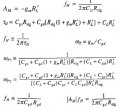The exercise states the following (Also the solution below the circuit diagram is from an unknown student):
In the Op Amp of the diagram below, gm1=gm2=1mA/V & gm6=3mA/V. The total capacitance between D2
and the ground is 0.2pF & between D6 and the ground 3pF. Find the compensation Cc such that the transient
frequency Ft = 40MHz and show that Ft is much less than Fz and Fp2.
The problem is I can not understand where are the following formulas that the student is using, are coming from.
According to Sedra & Smith book, \[ F_{t} = \frac{gm}{2\pi(C_{GS} + C_{GD})} \]
Also that 6 in the enumerator of Fp2 does not make any sense.
Note: Notice that the exercise does not tell you anything about VCC, VEE, |VA|, μ, Cox, W/L, Vt.
So you can't do anything to analyze the circuit, you just need to know the formulas that you have to use.

Also using the following formulas (Derived by Sedra & Smith) can not be useful because you are missing many variables:

In the Op Amp of the diagram below, gm1=gm2=1mA/V & gm6=3mA/V. The total capacitance between D2
and the ground is 0.2pF & between D6 and the ground 3pF. Find the compensation Cc such that the transient
frequency Ft = 40MHz and show that Ft is much less than Fz and Fp2.
The problem is I can not understand where are the following formulas that the student is using, are coming from.
According to Sedra & Smith book, \[ F_{t} = \frac{gm}{2\pi(C_{GS} + C_{GD})} \]
Also that 6 in the enumerator of Fp2 does not make any sense.
Note: Notice that the exercise does not tell you anything about VCC, VEE, |VA|, μ, Cox, W/L, Vt.
So you can't do anything to analyze the circuit, you just need to know the formulas that you have to use.

Also using the following formulas (Derived by Sedra & Smith) can not be useful because you are missing many variables:






